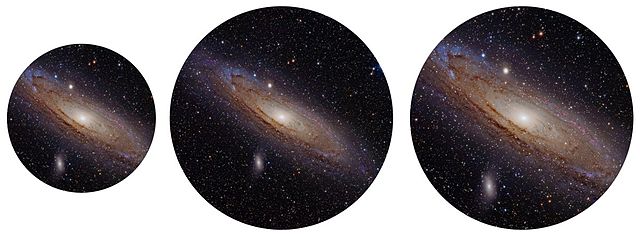An eyepiece, or ocular lens, is a type of lens that is attached to a variety of optical devices such as telescopes and microscopes. It is named because it is usually the lens that is closest to the eye when someone looks through an optical device to observe an object or sample. The objective lens or mirror collects light from an object or sample and brings it to focus creating an image of the object. The eyepiece is placed near the focal point of the objective to magnify this image to the eyes. The amount of magnification depends on the focal length of the eyepiece.
A collection of different types of eyepieces.
A 25 mm Kellner eyepiece
Simulation of views through a telescope using different eyepieces. The center image uses an eyepiece of the same focal length as the one on the left, but has a wider apparent field of view giving a larger image that shows more area. The image on the right has the same apparent field of view as the center eyepiece but has a shorter focal length, giving the same true field of view as the left image but at higher magnification.
The Plössl, an eyepiece with a large apparent field of view
An optical telescope is a telescope that gathers and focuses light mainly from the visible part of the electromagnetic spectrum, to create a magnified image for direct visual inspection, to make a photograph, or to collect data through electronic image sensors.
The Large Binocular Telescope at the Mount Graham International Observatory in Arizona uses two curved mirrors to gather light
Eight-inch refracting telescope at Chabot Space and Science Center
The Keck II telescope gathers light by using 36 segmented hexagonal mirrors to create a 10 m (33 ft) aperture primary mirror
Two of the four Unit Telescopes that make up the ESO's VLT, on a remote mountaintop, 2600 metres above sea level in the Chilean Atacama Desert.








